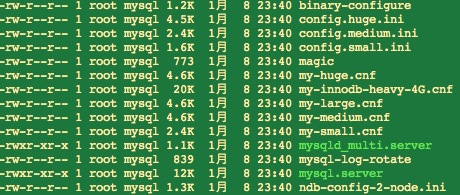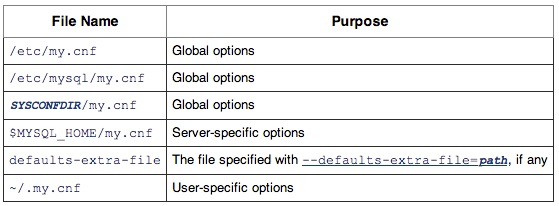MySQL配置信息解读(my.cnf)
从年后换了工作到现在差不多两个月了,比较忙,所以写博客的时间越来越少了。
以前学生时代用MySQL,从安装开始就是“下一步”,设置向导弄中设置用户、端口、编码什么的就好了。后来工作了公司用的Oracle,但是普通程序员也接触不到。现在正好有机会自己去接触一下数据库(MySQL),尽力把握住,搞清楚MySQL源码是如何编译的,是怎么配置的,存储引擎之间的区别等等。
这片博文记录一下自己理解的my.cnf(Window平台上的是my.ini)中的配置,这些配置官网应该都是有解释的吧?!可能是我自己没有找到好的资源。
my.cnf默认是不存在的,可以在mysql的安装目录的support-files中看到下面这些文件:

可以将my-huge.cnf、my-innodb-heavy-4G.cnf、my-large.cnf、my-medium.cnf、my-small.cnf中合适自己机器的文件拷贝命名成my.cnf。
下面详细看一下这几个配置文件的内容。
my-huge.cnf(巨大的、庞大的)
# Example MySQL config file for very large systems.
# 这是一个庞大的系统的配置示例
# This is for a large system with memory of 1G-2G where the system runs mainly
# MySQL.
# 一个拥有1至2G内存,主要用于运行MySQL的系统
# MySQL programs look for option files in a set of
# locations which depend on the deployment platform.
# You can copy this option file to one of those
# locations. For information about these locations, see:
# http://dev.mysql.com/doc/mysql/en/option-files.html
#
# In this file, you can use all long options that a program supports.
# If you want to know which options a program supports, run the program
# with the "--help" option.
# The following options will be passed to all MySQL clients
[client]
#password = your_password
port = 3306 端口号
socket = /tmp/mysql.sock mysql.sock文件是服务器与本地客户端进行通信的Unix套接字文件
# Here follows entries for some specific programs
# The MySQL server
[mysqld]
port = 3306 端口号
socket = /tmp/mysql.sock mysql.sock文件是服务器与本地客户端进行通信的Unix套接字文件
skip-locking 避免MySQL的外部锁定,减少出错几率增强稳定性。
key_buffer_size = 384M 指定索引缓冲区的大小,它决定索引处理的速度,尤其是索引读的速度
通过检查状态值Key_read_requests和Key_reads,可以知道key_buffer_size设置是否合理。比例key_reads /key_read_requests应该尽可能的低,至少是1:100,1:1000更好(上述状态值可以使用SHOW STATUS LIKE ‘key_read%’获得)
max_allowed_packet = 1M 设置最大包,限制server接受的数据包大小,避免超长SQL的执行有问题(当MySQL客户端或mysqld服务器收到大于max_allowed_packet字节的信息包时,将发出“信息包过大”错误,并关闭连接)
table_open_cache = 512 mysql每打开一个表都会读入一些数据到table_open_cache中,当mysql在这个缓存中找不到对应的信息时,才会去磁盘上直接读取
sort_buffer_size = 2M 查询排序时所能使用的缓冲区大小。注意:该参数对应的分配内存是每连接独占!如果有100个连接,那么实际分配的总共排序缓冲区大小为100 × 2 = 200MB。所以,对于内存在4GB左右的服务器推荐设置为6-8M。
read_buffer_size = 2M 读查询操作所能使用的缓冲区大小。和sort_buffer_size一样,该参数对应的分配内存也是每连接独享!read_buffer_size只对MyISAM表有效
read_rnd_buffer_size = 8M 对所有存储引擎的表都有限
myisam_sort_buffer_size = 64M MySQL重建索引时所允许的最大临时文件的大小 (当 REPAIR, ALTER TABLE 或者 LOAD DATA INFILE)
thread_cache_size = 8 服务器线程缓存这个值表示可以重新利用保存在缓存中线程的数量,当断开连接时如果缓存中还有空间,那么客户端的线程将被放到缓存中,如果线程重新被请求,那么请求将从缓存中读取,如果缓存中是空的或者是新的请求,那么这个线程将被重新创建,如果有很多新的线程,增加这个值可以改善系统性能
query_cache_size = 32M query_cache_size的工作原理:一个SELECT查询在DB中工作后,DB会把该语句缓存下来,当同样的一个SQL再次来到DB里调用时,DB在该表没发生变化的情况下把结果从缓存中返回给Client。这里有一个关建点,就是DB在利用Query_cache工作时,要求该语句涉及的表在这段时间内没有发生变更。那如果该表在发生变更时,Query_cache里的数据又怎么处理呢?首先要把Query_cache和该表相关的语句全部置为失效,然后在写入更新。那么如果Query_cache非常大,该表的查询结构又比较多,查询语句失效也慢,一个更新或是Insert就会很慢,这样看到的就是Update或是Insert怎么这么慢了。所以在数据库写入量或是更新量也比较大的系统,该参数不适合分配过大。而且在高并发,写入量大的系统,建系把该功能禁掉。
# Try number of CPU's*2 for thread_concurrency
thread_concurrency = 8 设置thread_concurrency的值的正确与否, 对mysql的性能影响很大, 在多个cpu(或多核)的情况下,错误设置了thread_concurrency的值, 会导致mysql不能充分利用多cpu(或多核), 出现同一时刻只能一个cpu(或核)在工作的情况。thread_concurrency应设为CPU核数的2倍. 比如有一个双核的CPU, 那么thread_concurrency的应该为4; 2个双核的cpu, thread_concurrency的值应为8
# Don't listen on a TCP/IP port at all. This can be a security enhancement,
# if all processes that need to connect to mysqld run on the same host.
# All interaction with mysqld must be made via Unix sockets or named pipes.
# Note that using this option without enabling named pipes on Windows
# (via the "enable-named-pipe" option) will render mysqld useless!
#
#skip-networking 开启该选项可以彻底关闭MySQL的TCP/IP连接方式,如果WEB服务器是以远程连接的方式访问MySQL数据库服务器则不要开启该选项!否则将无法正常连接!
# Replication Master Server (default)
# binary logging is required for replication
log-bin=mysql-bin 二进制日志包含所有更新数据的语句,其目的是在恢复数据库时用它来把数据尽可能恢复到最后的状态。另外,如果做同步复制( Replication )的话,也需要使用二进制日志传送修改情况。 开启二进制日志,需要设置参数log-bin。log_bin指定日志文件,如果不提供文件名,MySQL将自己产生缺省文件名
# required unique id between 1 and 2^32 - 1
# defaults to 1 if master-host is not set
# but will not function as a master if omitted
server-id = 1
# Replication Slave (comment out master section to use this)
#
# To configure this host as a replication slave, you can choose between
# two methods :
#
# 1) Use the CHANGE MASTER TO command (fully described in our manual) -
# the syntax is:
#
# CHANGE MASTER TO MASTER_HOST=<host>, MASTER_PORT=<port>,
# MASTER_USER=<user>, MASTER_PASSWORD=<password> ;
#
# where you replace <host>, <user>, <password> by quoted strings and
# <port> by the master's port number (3306 by default).
#
# Example:
#
# CHANGE MASTER TO MASTER_HOST='125.564.12.1', MASTER_PORT=3306,
# MASTER_USER='joe', MASTER_PASSWORD='secret';
#
# OR
#
# 2) Set the variables below. However, in case you choose this method, then
# start replication for the first time (even unsuccessfully, for example
# if you mistyped the password in master-password and the slave fails to
# connect), the slave will create a master.info file, and any later
# change in this file to the variables' values below will be ignored and
# overridden by the content of the master.info file, unless you shutdown
# the slave server, delete master.info and restart the slaver server.
# For that reason, you may want to leave the lines below untouched
# (commented) and instead use CHANGE MASTER TO (see above)
#
# required unique id between 2 and 2^32 - 1
# (and different from the master)
# defaults to 2 if master-host is set
# but will not function as a slave if omitted
#server-id = 2
#
# The replication master for this slave - required
#master-host = <hostname>
#
# The username the slave will use for authentication when connecting
# to the master - required
#master-user = <username>
#
# The password the slave will authenticate with when connecting to
# the master - required
#master-password = <password>
#
# The port the master is listening on.
# optional - defaults to 3306
#master-port = <port>
#
# binary logging - not required for slaves, but recommended
#log-bin=mysql-bin
#
# binary logging format - mixed recommended
#binlog_format=mixed
# Uncomment the following if you are using InnoDB tables 使用innoDB的配置
#innodb_data_home_dir = /usr/local/mysql/data INNODB保存数据目录
#innodb_data_file_path = ibdata1:2000M;ibdata2:10M:autoextend 指定表数据和索引存储的空间,可以是一个或者多个文件。最后一个数据文件必须是自动扩充的,也只有最后一 个文件允许自动扩充。这样,当空间用完后,自动扩充数据文件就会自动增长
#innodb_log_group_home_dir = /usr/local/mysql/data 日志位置
# You can set .._buffer_pool_size up to 50 - 80 %
# of RAM but beware of setting memory usage too high
#innodb_buffer_pool_size = 384M 定义了 InnoDB 存储引擎的表数据和索引数据的最大内存缓冲区大小。和 MyISAM 存储引擎不同, MyISAM 的 key_buffer_size 只能缓存索引键,而 innodb_buffer_pool_size 却可以缓存数据块和索引键。适当的增加这个参数的大小,可以有效的减少 InnoDB 类型的表的磁盘 I/O 。在一个以 InnoDB 为主的专用数据库服务器上,可以考虑把该参数设置为物理内存大小的 60%-80% 。
#innodb_additional_mem_pool_size = 20M 这个参数用来设置 InnoDB 存储的数据目录信息和其它内部数据结构的内存池大小。应用程序里的表越多,你需要在这里分配越多的内存。对于一个相对稳定的应用,这个参数的大小也是相对 稳定的,也没有必要预留非常大的值。如果 InnoDB 用光了这个池内的内存, InnoDB 开始从操作系统分配内存,并且往 MySQL 错误日志写警告信息。默认值是 1MB ,当发现错误日志中已经有相关的警告信息时,就应该适当的增加该参数的大小。
# Set .._log_file_size to 25 % of buffer pool size
#innodb_log_file_size = 100M
#innodb_log_buffer_size = 8M
#innodb_flush_log_at_trx_commit = 1如果设置为1,InnoDB会在每个提交磁盘冲洗事务日志,这提供了完整的ACID的行为。如果你想安全,并且正在执行一些小操作,你可以设置为0或者2在减少磁盘I / O日志。
#innodb_lock_wait_timeout = 50 InnoDB 有其内置的死锁检测机制,能导致未完成的事务回滚。但是,如果结合InnoDB使用MyISAM的lock tables 语句或第三方事务引擎,则InnoDB无法识别死锁。为消除这种可能性,可以将innodb_lock_wait_timeout设置为一个整数值,指示 MySQL在允许其他事务修改那些最终受事务回滚的数据之前要等待多长时间(秒数)
[mysqldump]
quick 没有指定 --quick 或 --opt 选项,则会将整个结果集放在内存中。如果导出大数据库的话可能会出现问题
max_allowed_packet = 16M
[mysql]
no-auto-rehash
# Remove the next comment character if you are not familiar with SQL
#safe-updates
[myisamchk]
key_buffer_size = 256M
sort_buffer_size = 256M
read_buffer = 2M
write_buffer = 2M
[mysqlhotcopy]
interactive-timeout 服务器关闭交互式连接前等待活动的秒数。交互式客户端定义为在mysql_real_connect()中使用
其他文件:my-large.cnf my-medium.cnf my-small.cnf是针对不同的机器性能的配置。my-innodb-heavy-4G.cnf是一个针对 4G 内存系统(主要运行只有 InnoDB 表的 MySQL 并使用几个连接数执行复杂的查询)的 MySQL 配置文件例子。
通过修改my.cnf的配置可以优化mysql的性能。my.cnf文件的存储位置会影响配置的有效性。





【推荐】国内首个AI IDE,深度理解中文开发场景,立即下载体验Trae
【推荐】编程新体验,更懂你的AI,立即体验豆包MarsCode编程助手
【推荐】抖音旗下AI助手豆包,你的智能百科全书,全免费不限次数
【推荐】轻量又高性能的 SSH 工具 IShell:AI 加持,快人一步
· .NET Core 中如何实现缓存的预热?
· 从 HTTP 原因短语缺失研究 HTTP/2 和 HTTP/3 的设计差异
· AI与.NET技术实操系列:向量存储与相似性搜索在 .NET 中的实现
· 基于Microsoft.Extensions.AI核心库实现RAG应用
· Linux系列:如何用heaptrack跟踪.NET程序的非托管内存泄露
· TypeScript + Deepseek 打造卜卦网站:技术与玄学的结合
· 阿里巴巴 QwQ-32B真的超越了 DeepSeek R-1吗?
· 【译】Visual Studio 中新的强大生产力特性
· 10年+ .NET Coder 心语 ── 封装的思维:从隐藏、稳定开始理解其本质意义
· 【设计模式】告别冗长if-else语句:使用策略模式优化代码结构